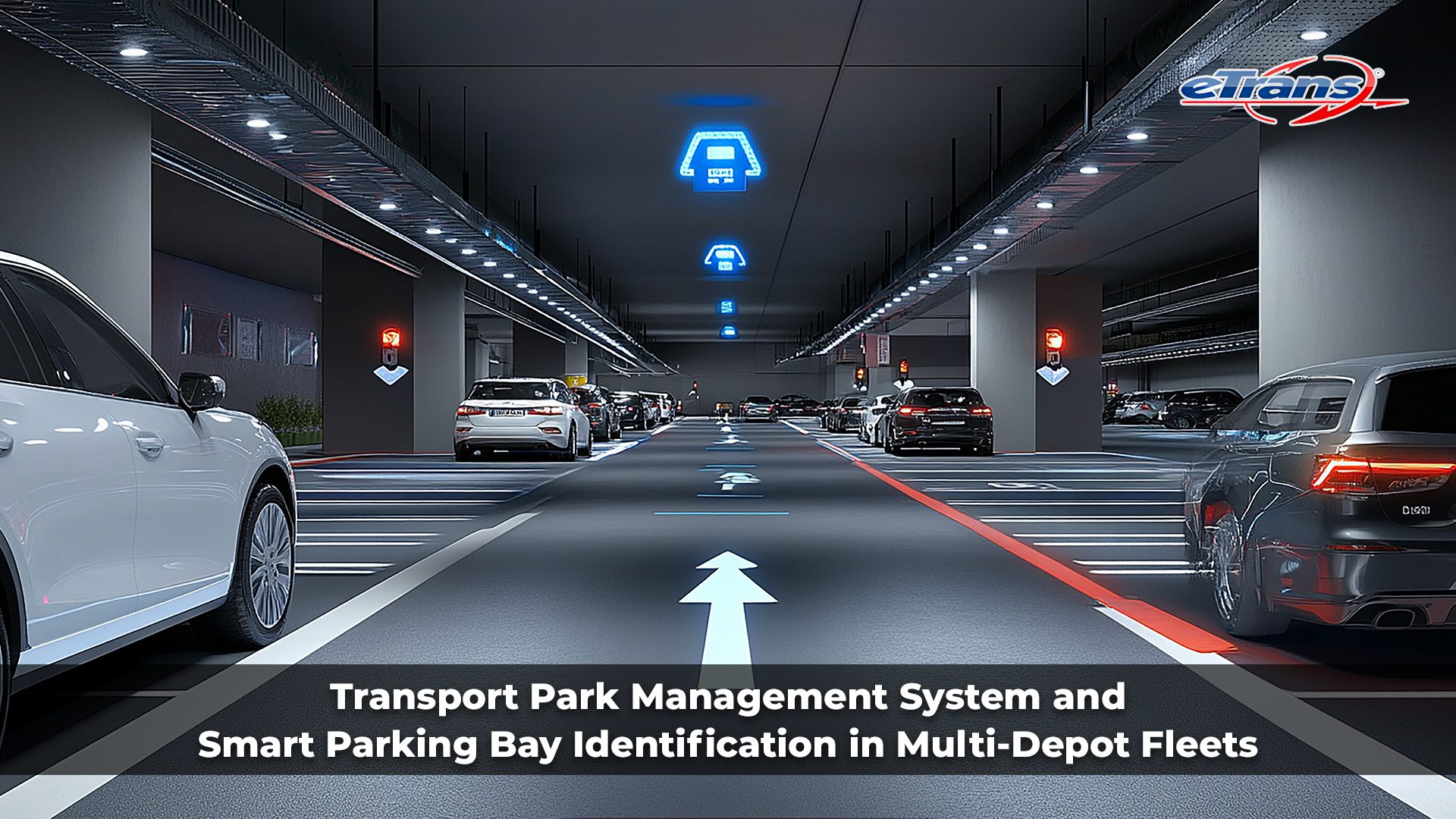Let’s face it — managing fleet parking across multiple depots feels like trying to play Tetris with trucks. Every vehicle wants a slot, every driver wants to leave early, and somehow, there’s always that one truck parked in the wrong bay blocking the exit. For fleet managers juggling hundreds of assets across sprawling yards, chaos is just another Tuesday.
That’s where the Transport Park Management System (TPMS) swoops in like a superhero with a tablet and a data plan. This smart system brings order to fleet yard management by combining IoT sensors, telematics, RFID technology, and real-time data analytics into one seamless command centre. Instead of clipboards and walkie-talkies, you get dashboards and predictive alerts.
Here’s the real kicker: in India’s rapidly growing logistics sector, where multi-depot operations are the norm, manual parking management is a slow leak in efficiency. A TPMS with smart parking bay identification fixes that leak — fast. It ensures that every truck knows exactly where to park, how long it’s been idle, and when it’s ready to roll again.
So, if you’re tired of yard confusion, detention time, and “Who parked that container there?”, stick around. By the end of this read, you’ll understand how digital parking intelligence is turning messy yards into models of precision.
The Rise of Intelligent Transport Park Management
The logistics industry has finally admitted it — we can’t run 21st-century fleets with 20th-century tools. As fleets expand and urban congestion worsens, intelligent transport park management has become a necessity, not a luxury.
A Transport Park Management System (TPMS) acts as the brain behind your vehicle bay allocation system, connecting GPS-enabled parking solutions, smart parking sensors, and yard automation software. It’s like having a digital air traffic controller for your fleet.
In Indian logistics yards, congestion isn’t just an inconvenience — it’s an operational black hole. Trucks pile up during loading, parking bays overlap, and security staff resort to frantic hand signals. Without real-time vehicle positioning and digital coordination, fleets waste fuel, time, and patience.
A smart TPMS automates the entire process. It tells you which bay is free, which truck overstayed its slot, and how to reroute traffic flow.
Simply put, smart parking isn’t just about where your truck parks — it’s about how your entire operation moves.
Understanding the Transport Park Management System (TPMS)
Imagine a central system that knows every vehicle in your operation, like when it entered, where it parked, how long it’s been there, and when it’s leaving. That’s the Transport Park Management System (TPMS) in a nutshell.
It combines automated gate entry systems, digital gate pass management, driver authentication, and parking bay allocation modules into one integrated dashboard. The system is constantly fed by fleet telematics integration, which tracks movement and position in real time.
As each truck approaches the yard, the system identifies it via RFID-based vehicle identification, authenticates its driver, and directs it to the nearest available bay using IoT-driven parking analytics. No guesswork. No shouting matches.
For Indian operators managing multiple depots, the TPMS offers more than convenience — it delivers data consistency and standardised parking protocols across all sites. Industrial hubs and logistics parks are already adopting these systems to eliminate manual dependency and reduce yard congestion.
The result? Every truck parks where it should. Every movement is logged. And every minute of detention time is accounted for.
Challenges of Managing Multi-Depot Fleets in India
Let’s be honest — running a single yard efficiently is hard enough. Managing five of them? That’s pure logistics warfare.
Multi-depot fleets in India face challenges that go far beyond congestion. Each depot has its own layout, staff habits, and “old-school” ways of doing things. Manual vehicle bay tracking means handwritten notes, delayed communication, and frequent misparking. The result is an endless cycle of wasted fuel, delayed shipments, and frustrated drivers.
Peak-hour congestion becomes a nightmare when incoming and outgoing trucks fight for space. Without a unified yard automation software, fleet managers can’t see which depot is full or underutilised. Add to that inconsistent asset location tracking, and you’ve got a recipe for inefficiency.
These issues aren’t minor—they snowball into underused assets, poor driver productivity, and massive cost overruns. Digitalisation through a Transport Park Management System breaks this cycle, creating one connected ecosystem where all depots “talk” to each other in real time.
Smart Parking Bay Identification: The Game-Changer
Here’s where the magic happens. Smart parking bay identification is like giving your fleet yard X-ray vision.
Using smart parking sensors, RFID tags, and GPS-enabled tracking, the system detects every bay’s occupancy status instantly. Each bay has an IoT sensor that tells the central dashboard whether it’s free, occupied, or reserved for an incoming truck.
So instead of drivers randomly circling the yard looking for space (and cursing under their breath), they’re automatically guided to the right spot. The TPMS assigns bays dynamically, based on vehicle type, cargo load, and dispatch priority.
For high-volume logistics zones like Bhiwandi or Dankuni, smart parking bay identification means smoother inbound scheduling, faster turnaround, and reduced detention. It also minimises fuel wastage from unnecessary idling and movement.
Essentially, your yard starts running like a Formula 1 pit crew — fast, precise, and perfectly choreographed.
Integration of Telematics with Smart Bay Management
Think of telematics as the nervous system of your fleet and TPMS as its brain. Together, they form a powerhouse of precision.
Fleet telematics integration ensures that vehicle data—like GPS coordinates, speed, and engine idle time—is shared directly with the TPMS. This enables real-time vehicle positioning and intelligent bay allocation.
If a truck is due for dispatch soon, the system assigns it a bay near the exit. If it’s under maintenance, it’s sent to a designated service bay. This level of automation helps fleet managers make data-driven decisions about parking, movement, and dispatch — all without lifting a phone.
The best part? You can monitor every depot remotely. Whether it’s Chennai or Chandigarh, your multi-yard logistics network operates under one synchronised system. It’s like having eyes everywhere — without needing a helicopter.
Role of RFID and IoT in Bay Allocation Automation
RFID and IoT — the dynamic duo that’s redefining how fleets park and move.
Each vehicle carries an RFID tag that communicates with yard readers at entry and exit points. As the vehicle enters, the system automatically registers its ID, logs its time, and assigns it a parking space optimised for its size and next route.
Meanwhile, IoT sensors placed in each bay detect whether it’s occupied. These sensors feed data to a central dashboard in real time. This means fleet managers always know which spaces are empty and which vehicles have overstayed.
In India’s large transport hubs, RFID-based vehicle identification eliminates the need for manual gate entries or handwritten logs. It also reduces human error — because let’s face it, no one wants to be the person who misplaced a truck.
The combination of RFID and IoT turns your yard into a self-organising ecosystem — efficient, traceable, and fully automated.
Data Analytics and AI-Driven Decision Support in Parking Management
If data is the new oil, then AI is the refinery.
Modern yard automation software doesn’t just collect data — it analyses it to make smarter decisions. Using AI-driven analytics, the system studies parking patterns, peak hours, and vehicle dwell times to predict congestion and suggest preventive actions.
For example, if one depot consistently faces a 20% overflow at 5 PM, the system can reallocate incoming vehicles to nearby depots automatically. This level of predictive intelligence ensures yard congestion management before it even happens.
In India’s evolving logistics environment, this kind of foresight is gold. Companies can plan dispatches better, optimise loading schedules, and maintain operational balance across the entire multi-yard logistics network.
Simply put, AI doesn’t just help you park smarter — it helps you plan smarter.
Benefits for Fleet Operators and Logistics Companies
Alright, let’s talk ROI — the part everyone actually cares about.
Deploying a Transport Park Management System with smart bay identification brings tangible, measurable benefits:
● Reduced detention time: Vehicles spend less time waiting, meaning faster turnaround and more trips per day.
● Improved utilisation rates: Every parking slot, driver, and asset is used to its full potential.
● Enhanced safety and security: Automated RFID-based vehicle identification ensures only authorised vehicles enter restricted zones.
● Access control mechanism: Allow vehicles that are authorised to move freely within the parking lot.
● Zero manual errors: No more scribbled logs or misplaced vehicles.
For companies handling FMCG, e-commerce, or industrial logistics, this translates into cost savings, higher operational efficiency, and happier customers.
A TPMS is like having a personal assistant for your entire yard — one that never sleeps, never argues, and never misplaces a truck.
Implementation Challenges and Industry Readiness in India
Now, before we get too dreamy — let’s talk reality.
Adopting TPMS in India isn’t plug-and-play. The initial investment is steep, especially for small operators. Then there’s the human factor — training staff to operate digital dashboards instead of traditional registers.
However, the landscape is shifting fast. Cloud-based TPMS models are making adoption easier and more affordable. As India’s transport logistics digitalisation gains momentum, government-backed initiatives are helping bridge the tech gap.
Fleet operators are slowly realising that automation isn’t optional anymore — it’s survival. And with scalable digital infrastructure, even mid-sized companies can embrace intelligent transport infrastructure without burning a hole in the budget.
Future of Smart Parking and Multi-Depot Automation
The future of fleet parking is smarter, greener, and more connected than ever.
We’re looking at IoT sensors and AI-powered visual bay detectionImagine a world where your TPMS talks directly to highways, tolls, and warehouse systems in real time.
Beyond efficiency, sustainability is becoming a core priority. Reduced idling means less waste and a comparative reduction in financial losses. Optimised movement means better generation of revenue by saving more on fuel consumption. And better space utilisation means smaller carbon footprints for all types of vehicles.
The writing’s on the wall — as India moves toward intelligent transport infrastructure, Transport Park Management Systems will become the digital backbone of logistics. The smart bay is the new command bay.
In a Nutshell
Managing a modern fleet without a Transport Park Management System is like navigating a maze blindfolded. You’ll eventually get there, but you’ll waste a ton of time (and fuel) in the process.
By combining smart parking sensors, RFID-based vehicle identification, and fleet telematics integration, TPMS brings order, accuracy, and agility to multi-depot operations. It ensures every asset is exactly where it should be, every trip is tracked, and every minute counts.
For Indian fleet operators, this isn’t just about automation — it’s about staying competitive in a digital-first logistics landscape. The smarter your yard, the faster your business moves.
In short, smart parking isn’t the future. It’s the new standard.
Frequently Asked Questions
1. What is a Transport Park Management System (TPMS)?
A TPMS is a digital solution that manages parking, entry, and movement of vehicles within fleet depots using IoT, RFID, and telematics integration.
2. How does smart parking bay identification work?
It uses IoT sensors and RFID technology to detect bay availability and automatically assign parking spots based on vehicle type and priority.
3. Why is TPMS essential for multi-depot fleets in India?
Manual yard management leads to congestion, misparking, and delays. TPMS ensures synchronisation and efficiency across all depots.
4. What technologies are integrated with TPMS?
Telematics systems, RFID-based vehicle identification, GPS tracking, and AI-driven data analytics work together to automate yard operations.
5. What are the key benefits of implementing TPMS?
Improved operational visibility, reduced detention time, optimised fuel use, enhanced safety, and smarter parking allocation across multiple depots.



